Fiasco Italo-Brittanico
Part 5: 1989 - Alfa picking up the pieces
Author
- Henri Greuter
Date
- February 16, 2009; revised on April 3, 2009, through the generous assistance of Johnny Capels
Related articles
- March-Alfa Romeo 90CA - Fiasco Italo-Brittanico, by Henri Greuter
- Introduction
- Part 1: Alfa's inverse Midas touch
- Part 2: Indy teams keep on March-ing
- Part 3: The Indy project that became a blackmail project
- Part 4: Patrick Racing, a brief history up to 1989
- Part 6: 1989 - Winning major prizes on the road to losing everything
- Part 7: 1989 - The first Alfa Romeo-powered CART racer
- Part 8: 1989 - A hopeful start for Alfa Romeo
- Part 9: Preparing for 1990
- Part 10: The 90CA in more detail
- Part 11: Exhaust solutions a 'waste' of effort?
- Part 12: 90CA on active duty - up to halfway into the month of May
- Part 13: 90CA on active duty - the early part of the second week of practice at Indianapolis
- Part 14: 90CA on active duty - wrestling through the second week of practice and qualifying
- Part 15: 90CA on active duty - about the Alfa Romeo V8 engine
- Part 16: 90CA on active duty - the last part of 'Indianapolis'
- Part 17: 90CA on active duty - after Indianapolis
- Part 18: The end of the road for March in CART and as a whole
- Part 19: The left-over hardware and where to find it
- Part 20: Final verdict on the March-Alfa Romeo 90CA
- Appendix I: Specifications
- Appendix II: Results and scores
- Appendix III: March-Alfa Romeo 90CA-related collectables and memorabilia
- March-Porsche 90P - The last oddball at the Indianapolis Motor Speedway, by Henri Greuter
Who?Howdy Holmes What?Alex Morales Racing March-Cosworth 88C Where?Indianapolis When?1988 Indianapolis 500 (final day of qualifying) |
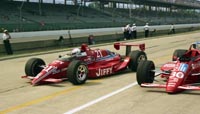 |
Why?
So what, at the end of 1987, could Alfa Romeo do to put its name again back in the front line of any kind of competition that was both popular worldwide and at the same time didn’t clash with the interests of other partners in the FIA group?
Sports cars could have been an option. During the spring of 1986, Lancia finally gave up on the Ferrari V8-powered, Martini sponsored LC2 sports cars. Somehow they couldn’t make the cars competitive during a 1000km race, challenging the multitude of Porsches on a regular basis, let alone beating them. LC2 appeared to stand for Lost Cause Two. But were Lancia genuinely fully committed to the Group C project? They were also active in rallying with a certain amount of success and their commitment to this line of motorsport had remained firm even after the tragedies that befell the team in Corsica in both ‘85 and ’86. Drastic rule changes were enforced which led to the demise of the highly spectacular Group B monsters, with Group A cars taking over World Championship status. Lancia fully committed themselves to these new rules. Meanwhile, GpC racing was left unattended by the FIAT group, so it could have been an option for Alfa Romeo to pick up the pieces and continue where Lancia had left off, be it with the available hardware and improve what was already available or start all over again given the lack of success of the Lancia hardware in the past years.
Then again, with the 164 and Spider cars about to be offered for sale in the USA, what about promoting sales by taking on an American racing formula? And one that happened to be rather popular too? A formula about which some recently obtained knowledge and technology was available within the FIAT group, but which had been discarded and was now collecting dust in a museum?
By now, it was 1988. Early 1988 there had been some talks about CART changing their engine formula from the mildly blown 2.65-litre V8s to unsupercharged 3.5-litre engines. Eventually the 2.65-litre engines were retained for the time to come. In the fall of 1988 Alfa Romeo announced they were to start a CART project with the intention of racing at Indianapolis. Alfa Corse had to design a turbocharged V8. It is sometimes suggested that the Alfa Romeo Indy V8 was an updated version of the Ferrari 034 V8 of prevous years, but this is not correct. Maybe the Ferrari had been an inspiration but mostly it gave a base on which to improve. The Ferrari 034 had been designed in a time when the Ford Cosworth DFX was the all-dominant engine but its reign had come to an end thanks to the new Chevrolet-sponsored Ilmor engine, which had set new standards of performance and from now on was the engine to beat.
But having learned lessons from Ligier in 1984 and Porsche in late 1987 and early 1988, Alfa decided to forego on developing their own chassis and join forces with an experienced partner. Experienced partners meant that there were only three options: Lola, March or Penske. The latter had iron-clad connections with Ilmor-Chevrolet (Roger Penske being a part owner of Ilmor…) and thus was never in contention. That left March and Lola.
What happened came as a bit of a surprise: Alfa signed a contract with March for their second works-supported factory effort in CART. This project was to be carried out independently from the Porsche effort, there was to be no exchange of information between the two groups. The Porsche efforts were carried out in the Bicester factory, the Alfa project found a home in Wyebridge in the old Ralt factories.
Certainly an interesting situation: one chassis builder involved with two engine manufacturers, building two different factory-supported CART contenders.
Alfa getting started
In October 1988 Alfa Romeo had started the design of a compact turbocharged V8 CART engine to start off their CART project with. This was to enable the chassis to have the largest ground effects diffuser possible as well as allowing the airflow to the rear wing to be as clean as possible. It took a reported four months to design the engine. Length, width and height were 585, 670 and 560mm, weight was quoted as 155kg. Bore and stroke were 86 and 57mm, giving a capacity of 2648cc. The power output was rated at 680hp at 11500rpm.
At first sight, this was lower than the claimed 710hp for the 1986 Ferrari 034 engine. This was a result of the reduction in maximum allowable turbo boost that was introduced in 1988 from 48 to 45 Inch mercury.
Though the Alfa V8 was inspired by the Ferrari 034 engine, the Alfa engine had a conventional design of exhausts on the outside and inlet plenum within the V. The engine design team was led by Claudio Lombardi and consisting of Giovanni Roffina, Luciano Caruso and Giuseppe D’Agostino. Special attention was given to the fact that the engine had to run on methanol and all the consequences related to the use of this fuel. During October 1988 the engine was still on the drawing board. In February 1989 however, it was running on the test bench. The engine made extensive use of small magnesium parts. Another weight-saving measure was the use of silicon aluminium cylinder liners within the cylinder block instead of more standard ductile iron liners. This alone saved 10kg. But some of the effects of all this weight reduction was lost because of the use of a harmonic balancer mounted on the rear of the crankshaft and then connected with flywheel and clutch. The balancer reduced the vibrations running along the crankshaft but its use made it necessary to enlarge the bellhousing. None of the other CART quadcam V8 engines used such a crankshaft balancer. The engine also got a fully electronic management system made by Magneti Marelli, complete with an electronically controlled wastegate for the turbocharger made by Garrett.
Alfa Romeo then teamed up with the remaining part of Morales Motorsports. Team manager of this long-time entrant at Indianapolis was Johnny Capels. When owner Alex Morales died of cancer late 1988 many wondered what was to happen to the team. It turned out, however, that Capels took over the assets of the team and went on. Eventually Capels played the major coup to become the factory-supported Alfa Romeo team. Another coup by Capels was that he managed to lure Roberto Guerrero away from Vince Granatelli Racing to drive the Alfa.
Morales Racing was one of the teams relying on Cosworth-powered March 88Cs during 1988. They had entered two cars at Indianapolis driven by Howdy Holmes. Holmes had big difficulties finding enough speed and in the last weekend of qualifying still practised both cars in order to find out which one was fast enough to make the field. The 1988 Hungness yearbook contains a nice diary written by chief mechanic Johnny Capels about what he and the team went through that year.
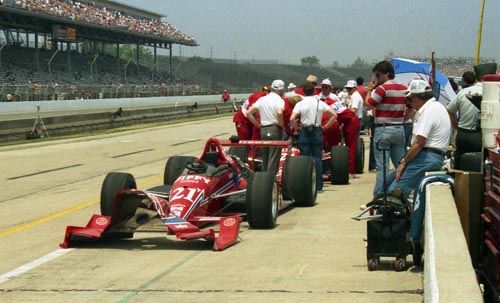
The two Team Morales 88Cs lined up in Pit Lane during the final weekend of qualifying. Driver Howdy Holmes still had to make up his mind about with which car he would try to make the race. (photo HG)
Holmes eventually qualified the number 21T backup car, chassis 88C-009, which was consequently raced as number 21. Holmes was the slowest qualifier that year, yet he still finished 12th with the car.

The 21T sees Howdy Holmes in his backup car, a March 88C entered by Alex Morales Racing. It is the final day of qualifying in 1988. Howdy made the field but was the slowest qualifier. 21T is chassis 88C-009, the car that eventually went to Italy and was fitted with the first Alfa Romeo V8 engines for test duties. The #30 is a Lola T88/00 bought during pole weekend by Team Shierson from AJ Foyt Racing to replace their recalcitrant 88Cs… (Photo HG)
Johnny Capels was very cooperative in responding to lots of questions about the period he worked with Alfa. He had the following to tell about how his team and Alfa Romeo teamed up.
“The March Engineering Alfa project was a project of Johnny Capels Enterprises DBA Alex Morales Autosports of which I was vice-president. My long time friend Alex had passed away in late 1988 and I went and brokered this arrangement between myself and March Engineering's Dave Reeves. I kept Alex Morales Autosports entity as the employer of our team and paid for those services as this was put together in Italy and England around Christmas of '88. I bought the few assets of Morales Autosports from the new leader of Alex Foods at the end of the '89 season as the shop and property and equipment was always mine in Indy. The negotiations went very well and I enjoyed working with the Alfa people very much. I was the team March was furnishing Alfa for this start up program. The Alfa leader was Cesare Fiorio, the project manager was Giorgio Pianta, and the operations manager was Claudio Chierici.”
When the deal between Alfa Corse and Capels Racing was made, and with the new Alfa-powered car to be built by March as well, the Capels-owned 88C-009 chassis went to Italy to become the Alfa test car. It was slightly modified to accept the Alfa V8.
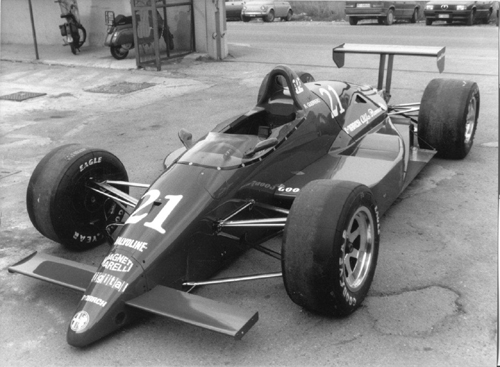
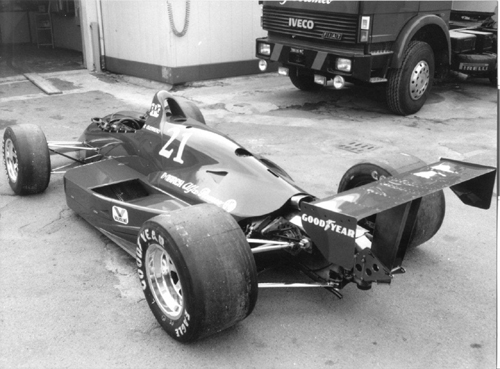
March 88C-009 converted into the Alfa engine muletta:, as it was used during the winter and early ’89 test sessions at Italy. (photos copyrights Alfacorse PR, supplied by Martin van der Hulst)
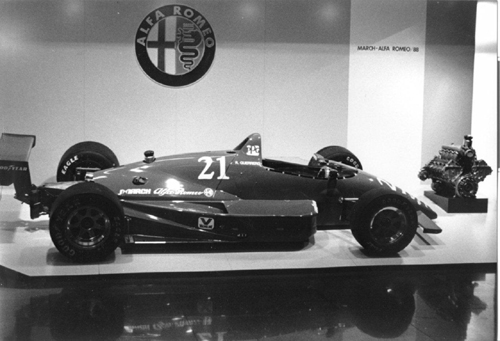
But Muletta 88C-009 wasn’t out on the track all the time: it was a PR tool on occasion too…
(photos copyrights Alfacorse PR, supplied by Martin van der Hulst)
Meanwhile, March had received the 88C and redesigned the car to accept the Alfa V8. The new car was designed by Maurice Philippe, a design veteran who had been involved with classics like the Lotus 49, 72 and the turbine-powered 56 Indianapolis cars of 1968. Also from his hand came the 1972 cars field by the Parnelli Superteam (the ones designed with those anhedral wings).
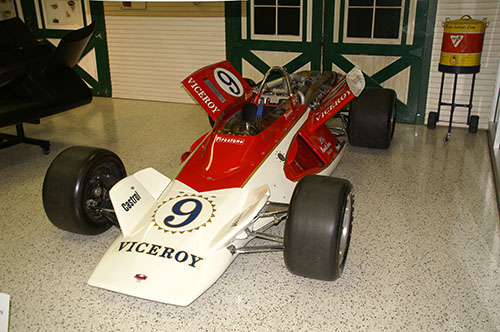
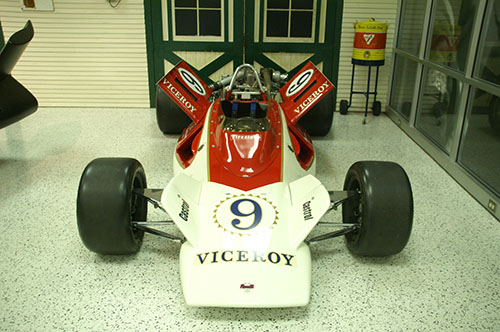
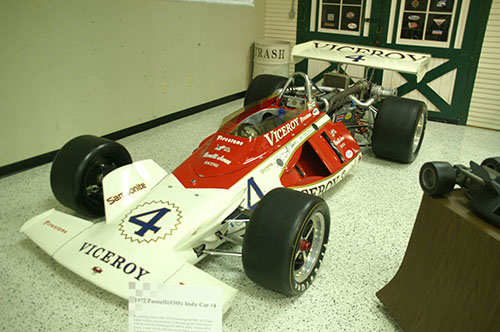
The turbine-powered 1968 Lotus 56 was Maurice Philippe's most remarkable revolutionary Indycar. More conventional powerplant-wise, although aerodynamically at least as revolutionary, was his 1972 design for Vel Miletich-Parnelli Jones Racing: the Parnelli VPJ1-Offy. Recently, the IMS Museum bought the Parnelli Jones collection and put these cars on display for a while. The number 9 is how the VPJ1 was supposed to look. When the cars failed miserably during practice they were hurridly converted into a more classic configuration in which the team's three cars managed to qualify for the race. None of the three drivers was ever in a position to challenge for the lead. But if eventual winner Mark Donohue had been forced to retire in the final stages as well, VPJ Racing would have scored a double victory and the number 4 would have made Al Unser the first and only man winning Indy three times in a row. Joe Leonard (third at Indy) won the USAC title that year with a sister car not shown here. (photos HG)
Philippe was assisted by Dave Reeves while Robin Herd was also supposed to provide assistance. The new car was designated 89CE. Philippe had also overseen the modifications on the 88C-009 into a suitable test car.
Johnny Capels also provided assistance by selling off two of his Cosworths to Alfa. These engines went to Abarth in order to provide a baseline on which to evaluate the progress of their own engine. Alfa got a rude awakening.
Capels’ Cosworths were sent to FIAT Abarth at Torino in order to provide a baseline to compare the Alfa V8 with. It turned out that the Alfa had some 100 hp less. It resulted in a number of changes made in specifications and people assigned on the project.
It was early 1989 by now. Slowly but surely things began to develop before unraveling themselves rapidly. Which would eventually lead to what happened in 1990.
